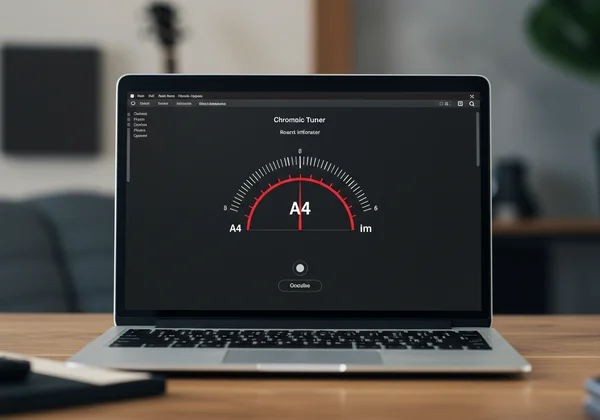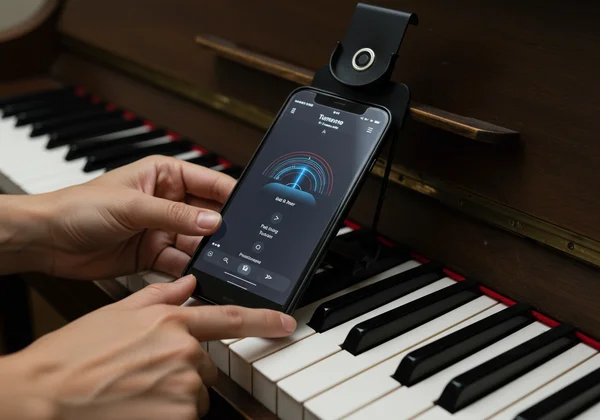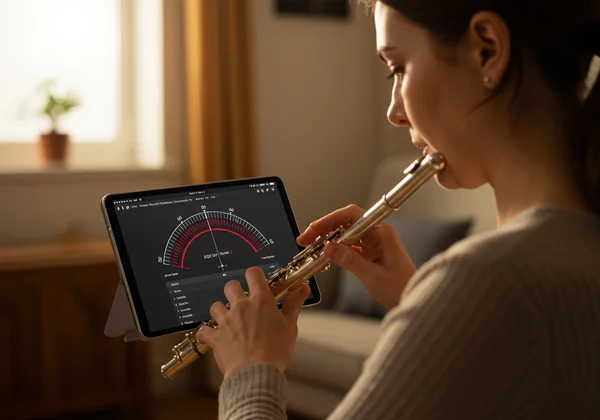The Ultimate Online Tuner: Tune Piano, Flute, Trumpet & More with Our Chromatic Tool
Ready to get the best sound from your instrument? While guitar and ukulele tuners are common, many musicians wonder, can I precisely tune other instruments like pianos, flutes, or trumpets online? Absolutely, you can. Discover how this versatile online instrument tuner breaks these barriers, offering accurate, free, and accessible tuning for nearly any instrument, right from your browser. Forget downloading clunky apps or buying expensive hardware; a professional-grade tuning experience is just a click away at our free online instrument tuner.
This guide will walk you through how to leverage this powerful technology for instruments far beyond the typical six-string. We'll explore why a browser-based chromatic tuner is a game-changer for musicians of all types.
Understanding the Universal Chromatic Tuner
The versatility of this tool stems from its function as a chromatic tuner. Unlike standard tuners that are pre-set for specific notes (like a guitar's E-A-D-G-B-E), a chromatic tuner detects and displays any of the 12 musical pitches in the Western scale. It listens for a frequency and tells you the closest note, along with whether it's sharp (too high), flat (too low), or perfectly in tune. This flexibility makes it an indispensable tool for a vast array of musical instruments.

What Makes Our Tool Your Go-To Online Instrument Tuner?
Our online tuner excels in precision, accessibility, and user experience. It uses your device’s microphone to analyze sound waves in real-time, providing instant visual feedback. Its core strengths include being a completely free online tuner with no ads, no registration, and no software to install. This commitment to a seamless, no-strings-attached experience is rare and highly commendable, establishing it as a trustworthy resource for musicians worldwide.
Why Online Tuning Is Ideal for Diverse Instruments
The convenience of an online tuner is a game-changer. For a music educator, it means having a single, uniform tool to recommend to all students, regardless of their instrument. For the gigging musician, it’s a lifesaver when a pedal tuner dies minutes before a set. For students learning orchestral or band instruments, it provides a free, reliable way to practice intonation at home. The ability to simply open a browser tab on a phone, tablet, or laptop and get immediate, accurate tuning feedback makes it the ultimate modern utility.
How to Tune a Piano with an Online Chromatic Tuner
While a full, professional piano tuning involves adjusting the tension of hundreds of strings and is best left to a qualified technician, an online chromatic tuner is an excellent tool for checking your piano's pitch. If you suspect your piano has gone out of tune due to humidity changes or age, you can quickly verify it.
Preparing for Piano Tuning: Microphone Placement & Best Practices
To get the most accurate reading, preparation is key. First, ensure the room is as quiet as possible to prevent the microphone from picking up stray sounds. Place your device (laptop or phone) near the piano, ideally with the microphone pointed toward the soundboard for an upright piano or the open lid for a grand piano. This helps capture a clear, strong signal for the instrument tuning.

Step-by-Step Piano Key Tuning with Our Online Tuner
- Navigate to the free online tuner on your device.
- When prompted, grant the website permission to access your microphone.
- Strike a single key firmly and let it sustain. A good starting point is Middle C (C4).
- Observe the tuner's display. It will show you the note name (C) and an indicator needle or color change to show if it's flat, sharp, or in tune.
- You can repeat this process for other key notes across the keyboard (e.g., A4, E3) to check the overall intonation. This method won't replace a technician, but it’s perfect to check your piano’s pitch and determine if it needs professional service.
Precision Tuning for Flute, Trumpet & Other Wind Instruments
For wind instrument players, intonation is a dynamic skill, influenced by breath support, embouchure, and even the temperature of the instrument. A flute tuner or trumpet tuner is essential for daily practice. The visual feedback from an online chromatic tuner provides an objective measure of your pitch that complements and sharpens your ear.
Quick Tips Before You Tune Brass and Woodwinds
Before you begin, it's crucial to warm up both yourself and your instrument. Play a few scales or long tones to get the air flowing and allow the instrument's material to reach a stable temperature, which significantly affects its pitch. When you are ready to tune, focus on using a steady, consistent airstream and a relaxed embouchure, as you would during normal play. This ensures the tuner measures your natural playing pitch.

Using Our Online Tuner for Accurate Wind Instrument Tuning
Tuning a wind instrument with this tool is straightforward and highly effective for wind instrument tuning practice.
- Open the Tuner.wiki online tool in your browser and allow microphone access.
- Play a standard reference note. For many orchestral settings, this is Concert A4 (440 Hz). For many bands, it’s Concert B-flat.
- Hold the note for several seconds, keeping your airflow and embouchure steady.
- Watch the tuner’s display. It will show whether your note is sharp or flat.
- Adjust accordingly. For a flute, you might roll the instrument slightly in or out or adjust the headjoint. For a trumpet, you will use the main tuning slide. Make small adjustments and re-check the note until the tuner shows it is perfectly centered.
Discover More: Instruments You Can Tune with Our Online Tuner
The power of a high-quality chromatic tuner extends across the entire musical spectrum. Its ability to detect any pitch makes it a universal tool for almost any sound source.
Beyond the Orchestra: Other Instruments Our Tuner Supports
The versatility of this browser tuner is its greatest asset. Beyond guitars, pianos, and wind instruments, you can use it for a wide range of others. This includes orchestral strings like the violin, viola, and cello, as well as folk instruments like the banjo, mandolin, and bouzouki. Even vocalists can use it to practice hitting specific pitches accurately. If it makes a clear, sustained musical tone, you can tune it with our online tuner.

Maximizing Your Tuning Experience Across All Instruments
To ensure the best results every time, follow a few simple guidelines. Always tune in a quiet environment to avoid interference. Place your device’s microphone as close to your instrument's sound source as is practical. Produce a clear, steady note and let it ring out. By following these best practices, you can explore all tunings with confidence, knowing you are getting a precise reading every time.
Unlock Perfect Pitch for Every Instrument
No longer are online tuners just for guitarists. With the advanced, browser-based chromatic technology of our online tuner, every musician has access to a precise, reliable, and completely free tuning tool. Whether you are a pianist checking your instrument's pitch, a flutist honing your intonation, a music teacher guiding your students, or a vocalist training your voice, this tool is for you. It empowers you to tune with confidence and play with passion.
Ready to get every note right? Visit the homepage and try the tuner here to experience the difference for yourself.
Frequently Asked Questions
1. Is an online tuner accurate enough for instruments like piano or flute?
Absolutely. For reference, practice, and checking your pitch, a high-quality online chromatic tuner is incredibly accurate. It uses sophisticated algorithms to analyze frequency. While a professional piano technician uses specialized tools for structural tuning, this tuner is perfect for verifying the pitch of individual notes and for daily intonation practice on a flute or trumpet.
2. How do I use a chromatic tuner to tune a non-string instrument?
The process is the same for any instrument. Simply produce a clear, sustained note into your device's microphone. The chromatic tuner will automatically detect the pitch, display the closest note in the musical scale (e.g., A, B♭, C#), and show you precisely how far you are from being perfectly in tune.
3. Can I tune my wind instrument with a phone and an online tuner?
Yes! Our online tuner is fully compatible with modern web browsers on smartphones, tablets, and computers. There is nothing to download. Just open the website on your phone's browser, allow microphone access, and you have a powerful and portable tuner ready to go. It’s an ideal solution for rehearsals, lessons, or backstage warm-ups. You can use our phone tuner anytime, anywhere.
4. What is the standard tuning for a flute or trumpet?
Flutes are typically C instruments, meaning when a flutist plays a written C, it sounds as a Concert C. Most trumpets are B♭ instruments, meaning their written C sounds as a Concert B-flat. However, you don't need to worry about these transpositions with a chromatic tuner. It displays the actual concert pitch your instrument is producing, making it simple to tune to any reference note, like Concert A=440Hz.